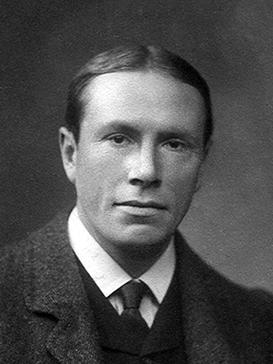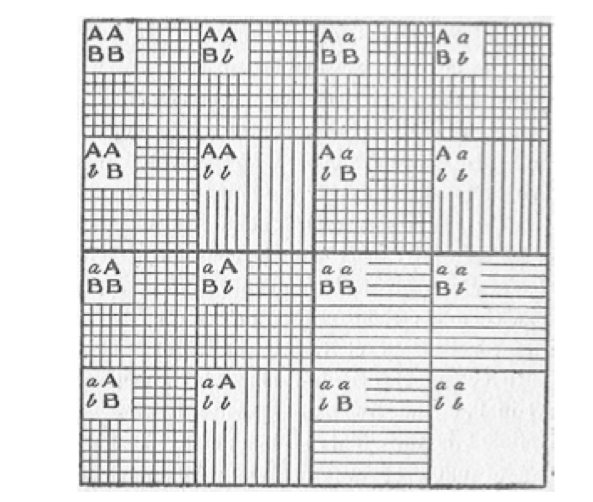
It is February 1908 and Reginald Punnett has just finished giving a lecture to the Royal Society of Medicine in London, when the unthinkable happens. He is ambushed by a question he cannot answer, posed by his enemies.
By 1908, Mendel’s ‘lost’ paper had been re-discovered for eight years. Punnett’s boss and mentor William Bateson, one of its re-discoverers, was making Cambridge the centre of the new “Mendelian genetics”. This annoyed a rival school of human geneticists based in London, centred around Karl Pearson. They called themselves the “Biometricians”.
The Biometricians were having an ongoing row with the Mendelians that was bitter and nasty. The row slowed down the acceptance of Darwin’s theory of evolution for many years.
There is a lot more about this fascinating argument and how it was resolved in chapter four of our book on Evolution published by Oxford University Press. You can find out more about the book here and on this website.
So, what was this killer question? Udney Yule hated Bateson and any idea of Mendelism, and he set Punnett a trap concerning brachydactyly. This is a medical condition where the fingers and toes are shorter than usual. It is caused by single gene and is a dominant characteristic.
Why, wondered Yule, innocently, if the condition was dominant, would we not expect to find three times more people with brachydactyly than normal length fingers, assuming random mating for this condition?
Punnett was stuck for an answer and burbled something about two Aa heterozygotes mating to produce more heterozygotes. This is true, but does not answer the question.
As luck would have it, the next day Punnett was playing cricket in Cambridge with the mathematician G.H. Hardy. Whilst they were waiting to bat, Punnett grumbled to Hardy about the question. Hardy is said to have scribbled a solution on a postcard, giving it to Punnett, with the comment, “I would have expected you and your colleagues to have known this already.” Hardy eventually published his solution in the journal Science in 1908.
So, what did Hardy write? Essentially, it was a new way of thinking about genetics. Mendelians studied the inheritance of characteristics in families produced by parents with known genotypes. The Biometricians did much the same with their human family trees. But populations are different: we cannot determine which individuals will breed to form the next generation.
The approach is to stop thinking about individuals and think about alleles instead. (In 1908, the terms ‘gene’ and ‘allele’ were not used, and Hardy did not use them, but it is easier, here, to use the modern terms.)
For a single gene, with two alleles, A and a, allele A is dominant to allele a. The frequencies of these alleles in a population are not known, so we can call:
the frequency of A = p
the frequency of a =q
(p+q)=1
Hardy pointed out that:
(p+q)2=12
(This is the binomial theory that is today taught in Year 12 mathematics.)
Expanding the equation:
p2+2pq+q2=1
This gives us the frequency of the genotypes:
AA = p2
Aa= 2pq
Aa= q2
So far, so good. But what about the next generation? Assuming random mating, each A allele is equally likely to combine with allele A or a. So, using Mendel’s method:
| Allele | A (p) | a (q) |
| A (p) | p2 AA | pq Aa |
| a (q) | pq Aa | q2 aa |
The genotype frequencies in the next generation are the same as the previous generation.
AA = p2
Aa= 2pq
Aa= q2
Because the allele (and their genotype) frequencies stay the same, they are said to be in equilibrium.
Yule’s hypothesis was shown to be false, the frequency of brachydactyly in the population will stay the same, given certain assumptions. The frequency will change only if the assumptions are not true. These assumptions are:
- random mating
- no mutation
- no immigration or emigration from the population,
- large population size (N>10)
- no selection of phenotypes.
By a cruel twist of fate, one month earlier, in January 1908, Wilheim Weinberg read a paper to a meeting in Stuttgart in Germany, in which he proposed the same equilibrium model. It was obviously an idea waiting to be discovered. History credits both people in the name ‘Hardy-Weinberg equilibrium’.
Punnett has been criticised for not thinking of the idea for himself, but this is rather unfair. Neither Yule, Bateson or Pearson saw it either, even though it develops directly from Mendel’s paper. At least Punnett recognised the problem and discussed it with Hardy, who was probably the best mathematician in the world. This is what excellent scientists do, they share questions and collaborate on answers.
Punnett became a professor of genetics and did important work testing the limits of Mendel’s ideas. In doing so, he and his colleagues discovered linkage and the effects of two genes on the same characteristic (epistasis). He was also able to improve the breeding of poultry. He was the author of the world’s best selling genetics textbook and introduced the Punnett square method of displaying crosses to the world. His students remember him as a caring and thoughtful teacher.

It just shows how useful cricket can be!
I am grateful to A.W. F. Edwards for his 2008 paper (Genetics 179: 1143-1150) for the inspiration for this story.

